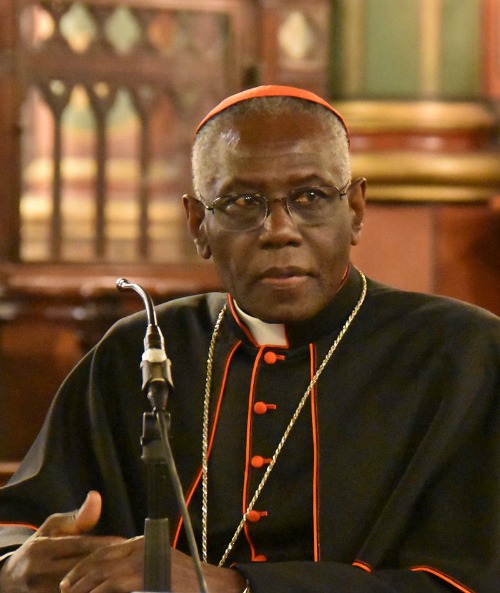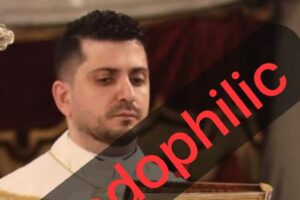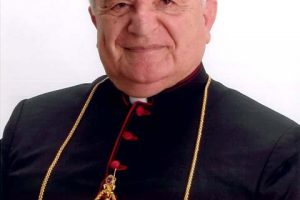Translation of an interview with the prefect of the Congregation for Divine Worship and the Sacraments, published by the French magazine Famille Chretienne.
Editor’s Note: The French magazine Famille Chretienne published an online interview with Cardinal Robert Sarah of Guinea on May 23. The following is a Register-commissioned translation from the original French.
Cardinal Robert Sarah, prefect of the Congregation for Divine Worship and the Discipline of the Sacraments, calls us to a serious reflection on the Eucharist. He also invites priests and the faithful to turn and “orient” themselves towards the East, “the Orient” — that is, to Christ.
Several weeks ago, you discussed a desire to see “The Sacrament of Sacraments put back in the central place,” that is, the Eucharist. What is your reasoning?
I wish to engage a serious consideration on this question, with the goal of placing the Eucharist back at the center of our lives. I have witnessed that, very often, our liturgies have become like theater productions. Often, the priest no longer celebrates the love of Christ through his sacrifice, but just a meeting among friends, a friendly meal, a brotherly moment. In looking to invent creative or festive liturgies, we run the risk of worship that is too human, at the level of our desires and the fashions of the moment. Little by little, the faithful are separated from that which gives life. For Christians, the Eucharist is a question of life and death!
How can we put God at the center?
The liturgy is the door to our union with God. If the Eucharistic celebrations are transformed into human self-celebrations, the peril is immense, because God disappears. One must begin by replacing God at the center of the liturgy. If man is at the center, the Church becomes a purely human society, a simple nonprofit, like Pope Francis has said. If, on the contrary, God is at the heart of the liturgy, then the Church recovers its vigor and sap! Cardinal Joseph Ratzinger prophetically wrote, “In our relationship with the liturgy, the destiny of the faith and of the Church plays out.”
What remedy do you recommend to us?
The recognition of the liturgy as the work of God implies a true conversion of the heart. The Second Vatican Council insisted on a major point: In this domain, the importance is not what we do, but what God does. No human work can ever accomplish what we find at the heart of the Mass: the sacrifice of the cross.
The liturgy permits us to go out past the walls of this world. To find the sacredness and the beauty of the liturgy requires, therefore, a work of formation for the laity, the priests and the bishops. It is an interior conversion.
To put God at the center of the liturgy, one must have silence: this capacity to silence ourselves [literally: “shut up”] to listen to God and his word. I believe that we don’t meet God except in the silence and the deepening of his word in the depths of our heart.
How do we do this concretely?
To convert is to turn towards God. I am profoundly convinced that our bodies must participate in this conversion. The best way is certainly to celebrate — priests and faithful — turned together in the same direction: toward the Lord who comes. It isn’t, as one hears sometimes, to celebrate with the back turned toward the faithful or facing them. That isn’t the problem. It’s to turn together toward the apse, which symbolizes the East, where the cross of the risen Lord is enthroned.
By this manner of celebrating, we experience, even in our bodies, the primacy of God and of adoration. We understand that the liturgy is first our participation at the perfect sacrifice of the cross. I have personally had this experience: In celebrating thus, with the priest at its head, the assembly is almost physically drawn up by the mystery of the cross at the moment of the elevation.
But is this way of celebrating the Mass authorized?
It is legitimate and conforms to the letter and the spirit of the Council. In my capacity as the prefect of the Congregation for Divine Worship and the Discipline of the Sacraments, I continue to remind all that the celebration toward the East (versus orientem) is authorized by the rubrics of the missal, which specify the moments when the celebrant must turn toward the people. A particular authorization is, therefore, not needed to celebrate Mass facing the Lord. Thus, in an article published by L’Osservatore Romano June 12, 2015, I proposed that the priests and the faithful turn toward the East at least during the Penitential Rite, during the singing of the Gloria, during the Propers and during the Eucharistic Prayer.
In the minds of many, the change of the orientation of the altar is tied to Vatican II. Is this accurate?
More than 50 years after the closure of Vatican II, it becomes urgent that we read these texts! The Council never required the celebration facing the people! This question is not even brought up by the Constitution [on Sacred Liturgy], Sacrosanctum Concilium. … What’s more, the Council Fathers wanted to emphasize the necessity for all to enter into participation of the celebrated mystery. In the years that have followed Vatican II, the Church has searched for the means of putting this intuition into practice.
Thus, to celebrate facing the people became a possibility, but not an obligation. The Liturgy of the Word justifies the face-to-face [orientation] of the lector and the listeners, the dialogue and the teaching between the priest and his people. But from the moment that we begin to address God — starting with the Offertory — it is essential that the priest and the faithful turn together toward the East. This corresponds completely with that which was willed by the Council Fathers.
I believe that we need to review the Council text. Certain adaptations to the local culture have probably not been fully developed enough. I have the translation of the Roman Missal in mind. In certain countries, important elements have been suppressed, notably the moment of the Offertory. In French, the translation of the Orate fratres has been truncated. The priest must say, “Pray my brothers that my sacrifice which is also yours would be agreeable to God the almighty Father.” And the faithful should respond: “May the Lord receive from your hands this sacrifice for the praise and the glory of his Name, for our good and that of all his Holy Church.” [Translator’s note: In French, currently the people respond: “For the glory of God and the salvation of the world.”] At the audience which the Pope granted me on Saturday, April 2, he confirmed that the new translation of the Roman Missal must imperatively respect the Latin text.
What do you think about the participation of the faithful?
The participation of the faithful is primary. It consists, first of all, of allowing ourselves to be led to follow Christ in the mystery of his death and of his resurrection. “One doesn’t go to Mass to attend a representation. One goes to participate in the mystery of God,” Pope Francis reminded us very recently. The orientation of the assembly toward the Lord is a simple and concrete means to encourage a true participation for all at the liturgy.
The participation of the faithful, therefore, would not be understood as a necessity to “do something.” On this point, we have deformed the teaching of the Council. On the contrary, it is to allow Christ to take us and associate us with his sacrifice. Only a view tempered in a contemplative faith keeps us from reducing the liturgy to a theater show where each has a role to play. The Eucharist makes us enter in the prayer of Jesus and in his sacrifice, because he alone knows how to adore in spirit and in truth.
What significance does the Church give to this question of orientation?
To begin with, we are not the only ones to pray “oriented,” that is, facing the East. The Jewish Temple and the synagogues were always facing East. In regaining this orientation, we can return to our origins. I note also that some non-Christians, the Muslims in particular, pray facing the East.
For us, the light is Jesus Christ. All the Church is oriented, facing East, toward Christ: ad Dominum. A Church closed in on herself in a circle will have lost her reason for being. For to be herself, the Church must live facing God. Our point of reference is the Lord! We know that he has been with us and that he returned to the Father from the Mount of Olives, situated to the East of Jerusalem, and that he will return in the same way. To stay turned toward the Lord, it is to wait for him every day. One must not allow God reason to complain constantly against us: “They turn their backs toward me, instead of turning their faces!” (Jeremiah 2:27).
Reference http://m.ncregister.com/49622/d#.V1J9LEfN6Ul














